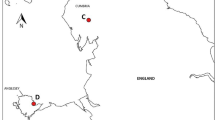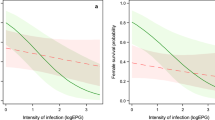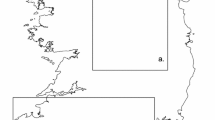Abstract
The squirrel poxvirus (SQPV) is the probable mediator of apparent competition between the introduced invading gray squirrel (Sciurus carolinensis) and the red squirrel (Sciurus vulgaris) in the UK, and modeling studies have shown that this viral disease has had a significant impact on the decline of the red squirrel in the UK. However, given our limited understanding of the epidemiology of the disease, and more generally the effects of invasive species on parasite ecology, there is a need to investigate the transmission dynamics and the relative pathogenicity of the virus between species. We aimed to increase our knowledge of these processes through an empirical study in which we: (i) used pathological signs and transmission electron microscopy (TEM) to diagnose SQPV disease in red squirrels found dead during scanning surveillance between 1993 and 2005; (ii) detected antibody to SQPV using an enzyme-linked immunosorbent assay (ELISA) in the same animals; and (iii) mapped cases of the disease, and the gray squirrel distribution, using a geographical information system. We analyzed the distribution of cases of SQPV disease according to woodland type, a measure of squirrel density. SQPV disease occurred only in areas of England also inhabited by seropositive gray squirrels, and as the geographical range of gray squirrels expanded, SQPV disease occurred in these new gray squirrel habitats, supporting a role for the gray squirrel as a reservoir host of the virus. There was a delay between the establishment of invading gray squirrels and cases of the disease in red squirrels which implies gray squirrels must reach a threshold number or density before the virus is transmitted to red squirrels. The spatial and temporal trend in SQPV disease outbreaks suggested that SQPV disease will have a significant effect on Scottish populations of red squirrels within 25 years. The even spread of cases of disease across months suggested a direct rather than vector-borne transmission route is more likely. Eight juvenile and sub-adult free-living red squirrels apparently survived exposure to SQPV by mounting an immune response, the first evidence of immunity to SQPV in free-living red squirrels, which possibly suggests a changing host-parasite relationship and that the use of a vaccine may be an effective management tool to protect remnant red squirrel populations.


Similar content being viewed by others
References
Best SM, Collins SV, Kerr P (2000) Coevolution of host and virus: cellular localization of virus in myxoma virus infection of resistant and susceptible European rabbits. Virology 277:76–91
Buller RMI, Palumbo GJ (1991) Poxvirus pathogenesis. Microbiological Reviews 55:80–122
Carroll B, Russell P, Gurnell J, Nettelton P, Sainsbury AW (in press) Epidemics of squirrelpox virus disease in red squirrels (Sciurus vulgaris): temporal and serological findings. Epidemiology and Infection
Cleaveland S, Hess GR, Dobson AP, Laurenson MK, McCallum HI, Roberts MG, et al. (2001) The role of pathogens in biological conservation. In: Hudson PJ, Rizzoli A, Grenfell BT, Hesterbeek H, Dobson AP (eds.), The Ecology of Wildlife Diseases, Oxford, UK: Oxford University Press, pp 139–150
Dobson AP, Hudson PJ (1995) Microparasites: observed patterns in wild animal populations. In: Grenfell BT, Dobson AP (eds.), Ecology of Infectious Diseases in Natural Populations. Cambridge, UK: Cambridge University Press, pp 52–89
Edwards FB (1962) Red squirrel disease. Veterinary Record 74:739
Fuller RM, Groom GB, Jones (1994) The land cover map of Great Britain: an automated classification of Landsat Thematic Mapper data. Photogrammetric Engineering and Remote Sensing 60:553–562
Goheen JR, Swihart RK, Gehring TM, Miller MS (2003) Forces structuring tree squirrel communities in landscapes fragmented by agriculture: species differences in perceptions of forest connectivity and carrying capacity. Oikos 102:95–103
Gurnell J (1991) Rodents. In: Corbet GB, Harris S (eds.), The Handbook of British Mammals, 3rd ed., Oxford, UK: Blackwell Scientific, pp 176–298
Hazel SM, Bennett M, Chantrey J, Bown K, Cavanagh R, Jones TR, et al. (2000) A longitudinal study of an endemic disease in its wildlife reservoir: cowpox and wild rodents. Epidemiology and Infection 124:551–562
Keymer IF (1974) Report of the pathologist, 1971 and 1972. The Zoological Society of London, Scientific Report 1971–1973. Journal of Zoology (London) 173:55
Keymer IF (1976) Report of the pathologist 1973 and 1974. The Zoological Society of London. Scientific Report 1974–1976. Journal of Zoology (London) 178:479
Koprowski J (1994) Sciurus carolinensis. Mammalian Species 480:1–9
Lloyd HG (1962) The distribution of squirrels in England. Journal of Animal Ecology 31:157–165
Lloyd HG (1983) Past and present distribution of red and grey squirrels. Mammal Review 13:69–80
Lowe VPE (1993) The spread of the grey squirrel into Cumbria since 1960 and its present distribution. Journal of Zoology (London) 231:663–667
Lurz PWW, Garson PJ, Rushton SP (1995) The ecology of squirrels in spruce dominated plantations: implications for management. Forest Ecology and Management 79:79–90
McCallum H, Dobson A (1995) Detecting disease and parasite threats to endangered species and ecosystems. Trends in Ecology and Evolution 10:190–194
McInnes CJ, Wood AR, Thomas K, Sainsbury AW, Gurnell J, Dein FJ, et al. (2006) Genomic characterization of a novel poxvirus contributing to the decline of the red squirrel (Sciurus vulgaris) in the UK. Journal of General Virology 87:2115–2125
Middleton AD (1930) The ecology of the American grey squirrel (Sciurus carolinensis Gmelin) in the British Isles. Proceedings of the Zoological Society of London 2:809–843
Middleton AD (1935) The distribution of the grey squirrel (Sciurus carolinensis) in Great Britain in 1935. Journal of Animal Ecology 4:274–276
Murphy FA (1999) Poxviridae. In: Veterinary Virology, 3rd ed., London: Academic Press, pp 278–291
Randolph SE, Chemini C, Furlanello C, Genchi C, Hails RS, Hudson PJ, et al. (2001) The ecology of tick-borne infections in wildlife reservoirs. In: The Ecology of Wildlife Diseases, Hudson PJ, Rizzoli A, Grenfell BT, Hesterbeek H, Dobson AP (editors), Oxford: Oxford University Press, pp 119–138
Reynolds JC (1985) Details of the geographic replacement of the red squirrel (Sciurus vulgaris) by the grey squirrel (Sciurus carolinensis) in eastern England. Journal of Animal Ecology 54:149–162
Robinson AJ, Kerr PJ (2001) Poxvirus infections. In: Infectious Diseases of Wild Mammals, Williams ES, Barker IK (editors), 3rd ed., London: Manson Publishing, pp 179–201
Rushton SP, Lurz PWW, Gurnell J, Fuller R (2000) Modelling the spatial dynamics of parapoxvirus disease in red and grey squirrels: a possible cause of the decline of the red squirrel in the UK? Journal of Applied Ecology 37:997–1012
Rushton SP, Lurz PWW, Gurnell J, Nettleton P, Bruemmer C, Shirley MDF, et al. (2006) Disease threats posed by alien species: the role of a poxvirus in the decline of the native red squirrel in Britain. Epidemiology and Infection 134:521–533
Sainsbury AW, Gurnell J (1995) An investigation into the health and welfare of red squirrels, Sciurus vulgaris, involved in reintroduction studies. Veterinary Record 137:367–370
Sainsbury AW, Kirkwood JK, Bennett PM, Cunningham AA (2001) Status of wildlife health monitoring in the United Kingdom 2001. Veterinary Record 148:558–563
Sainsbury AW, Nettleton P, Gilray J, Gurnell J (2000) Grey squirrels have high seroprevalence to a parapoxvirus associated with deaths in red squirrels. Animal Conservation 3:229–233
Sainsbury AW, Nettleton P, Gurnell J (1997) Recent developments in the study of parapoxvirus in red and grey squirrels. In: Gurnell J, Lurz PWW (eds) The Conservation of Red Squirrels Sciurus vulgaris L. London: Peoples Trust for Endangered Species, pp 105–108
Sainsbury AW, Ward L (1996) Parapoxvirus infection in red squirrels. Veterinary Record 138:400
Scott AC, Keymer IF, Labram J (1981) Parapoxvirus infection of the red squirrel (Sciurus vulgaris). Veterinary Record 109:202
Shorten MR (1954) Squirrels, London: Collins
Smith SA, Kotwal GJ (2002) Immune response to poxvirus infections in various animals. Critical Reviews in Microbiology 28:149–185
Temperley GW (1952) The past and present status of squirrels in Northumberland and Durham. Transactions of the Northumberland and Durham Natural History Society 10:153–164
Thomas K, Tompkins DM, Sainsbury AW, Wood AR, Dalziel R, Nettleton PF, et al. (2003) A novel poxvirus lethal to red squirrels (Sciurus vulgaris). Journal of General Virology 84:3337–3341
Tompkins DM, Sainsbury AW, Nettleton P, Buxton D, Gurnell J (2002) Parapoxvirus causes a deleterious disease in red squirrels associated with UK population declines. Proceedings of the Royal Society of London. Series B: Biological Sciences 269:529–533
Tompkins DM, White AR, Boots M (2003) Ecological replacement of native red squirrels by invasive greys driven by disease. Ecology Letters 6:1–8
Trout RC, Ross J, Tittensor AM, Fox AP (1992) The effect on a British wild rabbit population (Oryctolagus cuniculus) of manipulating myxomatosis. Journal of Applied Ecology 29:679–686
Vizoso AD (1968) A red squirrel disease. Symposia of the Zoological Society of London 24:29–38
Wauters LA, Lurz PWW, Gurnell J (2000) The interspecific effects of grey squirrels (Sciurus carolinensis) on the space use and population dynamics of red squirrels (S. vulgaris) in conifer plantations. Ecological Research 15: 271–284
Acknowledgments
The Institute of Zoology acknowledges the financial support of Natural England, Peoples Trust for Endangered Species, Joint Nature Conservation Committee, and the Zoological Society of London. The VLA acknowledges the financial support of DEFRA. The Moredun Research Institute acknowledges the financial support of SEERAD. The Tullie House Museum, Cumbria Wildlife Trust, Northumbria Natural History Society, and the Northumberland Wildlife Trust kindly allowed us to use sightings records, and we particularly thank Louise Bessant for help here. We also thank Forest Enterprise, Kielder Forest District, and in particular Bill Burlton and Neville Geddes for their support of the work. Bernadette Carroll assisted with the GIS analysis. Many veterinarians assisted with postmortem examinations, including Heather Ainsworth, Martin Cooke, Jane Cooper, David Couper, Andrew Cunningham, Javier Lopez, Hisako Ohira, Amalia Kountouri, Ann Pocknell, Taina Strike, and Maged Taema. Aviva Petrie assisted with the statistical tests. Maps of administrative boundaries in the UK were reproduced from Ordnance Survey map data by permission of the Ordnance Survey © Crown copyright 2001.
Author information
Authors and Affiliations
Corresponding author
Rights and permissions
About this article
Cite this article
Sainsbury, A.W., Deaville, R., Lawson, B. et al. Poxviral Disease in Red Squirrels Sciurus vulgaris in the UK: Spatial and Temporal Trends of an Emerging Threat. EcoHealth 5, 305–316 (2008). https://doi.org/10.1007/s10393-008-0191-z
Received:
Revised:
Accepted:
Published:
Issue Date:
DOI: https://doi.org/10.1007/s10393-008-0191-z




